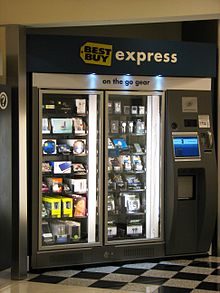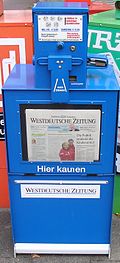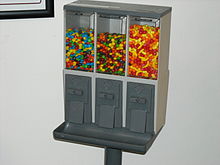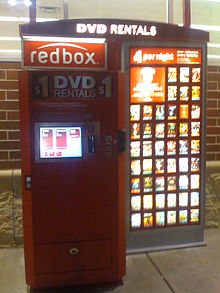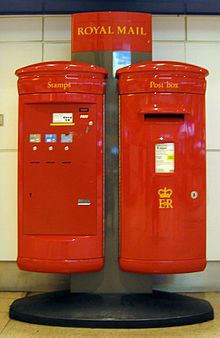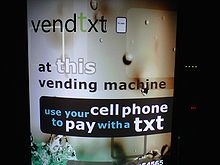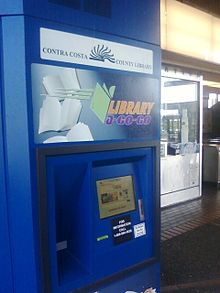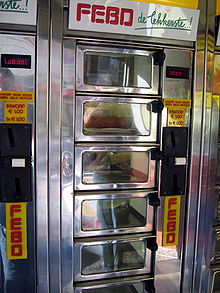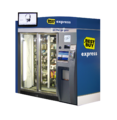- Vending machine
-
See also: Automated Retail
A vending machine is a machine which dispenses items such as snacks, beverages, alcohol, cigarettes, lottery tickets, consumer products and even gold and gems to customers automatically, after the customer inserts currency or credit into the machine.
Contents
History
The first reference to a vending machine is in the work of Hero of Alexandria, a first-century engineer and mathematician. His machine accepted a coin and then dispensed holy water.[1][2] When the coin was deposited, it fell upon a pan attached to a lever. The lever opened a valve which let some water flow out. The pan continued to tilt with the weight of the coin until it fell off, at which point a counterweight snapped the lever up and turned off the valve.
Vending machines waited for the Industrial Age before coming to prominence. The first modern coin-operated vending machines were introduced in London, England in the early 1880s, dispensing post cards. The first vending machine in the U.S. was built in 1888 by the Thomas Adams Gum Company, selling gum on New York City train platforms. The idea of adding games to these machines as a further incentive to buy came in 1897 when the Pulver Manufacturing Company added small figures, which would move around whenever somebody bought some gum from their machines. This idea spawned a whole new type of mechanical device known as the "trade stimulators". The birth of slot machines and pinball is ultimately rooted in these early devices.
In December 1970, Ussery Industries of Dallas, Texas at its Dallas convention displayed its "talking" vending machine, the Venda Talker. With insertion of a coin, the machine said "thank you" and added a one-liner voiced by comic Henny Youngman.
Mechanism
After paying, a product may become available by:
- the machine releasing it, so that it falls in an open compartment at the bottom, or into a cup, either released first, or put in by the customer, or
- the unlocking of a door, drawer, or turning of a knob.
Some products need to be prepared to become available. For example, tickets are printed or magnetized on the spot, and coffee is freshly concocted. One of the most common form of vending machine, the snack machine, often uses a metal coil which when ordered rotates to release the product.
The main example of a vending machine giving access to all merchandise after paying for one item is a newspaper vending machine (also called vending box) found mainly in U.S. It contains a pile of identical newspapers. After a sale the door automatically returns to a locked position. A customer could open the box and take all of the newspapers or, for the benefit of other customers, leave all of the newspapers outside of the box, slowly return the door to an unlatched position, or block the door from fully closing, each of which are frequently discouraged, sometimes by a security clamp. The success of such machines is predicated on the assumption that the customer will be honest (hence the nickname "honor box"), and need only one copy.
Bulk candy and gumball vending
Main articles: Bulk vending and Gumball machineBulk candy machines are mechanical machines that vend a handful of candy, a bouncy ball, or perhaps a capsule with a small toy or jewelry, for one or two coins. The items may be unsorted; in that case what the customer exactly gets is subject to chance. In other instances, the customer is guaranteed a specific type of candy.
The gross margins in the bulk candy business can be quite high — gumballs, for instance, can be purchased in bulk for 2 cents apiece and sold for 25 cents in the US. Gumballs and candy have a relatively long shelf life, enabling vending machine operators to manage many machines without too much time or cost involved.[3] In addition, the machines are typically inexpensive compared to soft drink or snack machines, which often require power and sometimes refrigeration to work. Many operators donate a percentage of the profits to charity so that locations will allow them to place the machines for free.
Bulk vending may be a more practical choice than soft drink/snack vending for an individual who also works a full-time job, since the restaurants, retail stores, and other locations suitable for bulk vending may be more likely to be open during the evening and on weekends than venues such as offices that host soft drink and snack machines.
Cigarette vending
Cigarettes were commonly sold in the United States through these machines, but this is increasingly rare due to concerns about underage buyers. This is similar to the situation in the UK, where many machines in pubs and clubs have been removed. Sometimes a pass has to be inserted in the machine to prove one's age before a purchase can be made. In Germany and Japan cigarette machines are still common.
Since 2007, however, age verification has been mandatory in Germany - buyers must be 18 or over. The various machines installed in pubs and cafés, other publicly accessible buildings and on the street accept one or more of the following as proof of age: the buyer's identity card, bank debit card (smart card) or European Union driver's license.
Full-line vending
 A full line of vending machines in a hospital cafeteria, including machines for drinks, snacks, and microwaveable foods.
A full line of vending machines in a hospital cafeteria, including machines for drinks, snacks, and microwaveable foods. Main article: Full-line vending
Main article: Full-line vendingA full-line vending company may set up several types of vending machines that sell a wide range of products. Products may include candy, cookies, chips, fresh fruit, milk, cold food, coffee and other hot drinks, bottles, cans of soda, and even frozen products like ice cream. These products can be sold from machines that include coffee, snack, cold food, 20-oz. bottle machines, and glass-front bottle machines. Almost all machines accept bills with more and more machines accepting $5 bills. This is an advantage to the vendor because it virtually eliminates the need for a bill changer. Larger corporations with cafeterias will often request full line vending with food service.
Specialized vending
In the Western world, some vending machines dispense personal products, typically in public toilet facilities. The machines in ladies' restrooms typically sell some form of absorbent device for menstruation, such as pads or tampons. The machines in men's rooms, when they are present, are most commonly for the sale of condoms, though in some locations they may be found dispensing cologne, medicine, small candies, or even pornography.[4] These are often found at toilets used by transient persons in high traffic locations, such as bus stations, shopping centres, airports and service stations. From the 1950s until well into the 1970s, vending machines were used at American airports to sell life insurance policies covering death, in the event that the buyer's flight crashed. Such policies were quite profitable, because the risk of a plane crash is low. However this practice gradually disappeared due to the tendency of American courts to strictly construe such policies against their sellers, such as Mutual of Omaha.[5]
From 2000-2010, specialization of vending machines became more common. Vending extended increasingly into non-traditional areas like electronics. Machines of this new category are generally called Automated Retail kiosks. The trend of specialization and proliferation of vending machines is perhaps most apparent in Japan where vending machines sell products from toilet paper to hot meals and pornography, and there is 1 vending machine per 23 people.[6] Containers of live bait are sold in vending machines in the rural United States.
Safety and security issues
Risk of falling machines
Most modern vending machines are tested and designed to inhibit theft, with security measures resulting in designs similar in strength to safes. As a result, the machines can be very heavy.
A few people have been fatally injured after having a vending machine topple over them, either while they were attempting to steal from the machine, or venting frustration over a malfunction which caused a failure to dispense the purchased item or the proper change. An article in the Journal of the American Medical Association (11 November 1988, p. 2697) documents 15 cases in which men trying to get a can out of the machine were crushed. Three died, the other 12 required hospitalization for injuries such as fractures of the skull, toe, ankle, tibia, femur, and pelvis; intracerebral bleeding; knee contusion; and one punctured bladder. The article states that because the soft drinks are located in the upper half of the machine (so that they can fall into the dispensing slot), the center of gravity of the machine is abnormally high. Because of this high center of gravity, the machine will fall over once it has been tipped only 20 degrees, a deceptively small angle. A large, fully loaded soft drink machine can weigh over 400 kg (880 lbs.)
Coin fraud
One issue with vending machines, particularly mechanical vending machines, involves the use of coins of foreign currency, or, in more extreme cases, worthless tokens or washers, which have the same size and shape as the coin accepted by the machine. This is done to pay less for merchandise, and some times in order to get change that has more value than the originally inserted object.
One remarkable example of this was the use of Libyan coins of 100 Dirhams and 50 Dirhams denominations in Maltese vending machines in the late 1990s. The 100 Dirham coin was used in place of the 1 Maltese Lira coin which had, back then, a de facto black market value of approximately 10 Libyan Dinars and thus having a value 100 times higher than that of the fraudulent coin. Similarly, the 50 Dirhams coin was used in place of the 25 Maltese cent, which meant a 50-fold increase of value according to the black market price. However, this problem was quickly solved when the machines involved were quickly replaced with new ones that could detect the difference between the Libyan and the Maltese coins, especially in tourist areas. In another case, the 2 euro coin is similar in size to the 10 baht coin (worth only €0.25). As a result, many vending machines in the eurozone will not accept €2 coins, such is the extent of the 10-baht scam.[7]
In the United States, most vending machines can discern coins by reading the coins' "magnetic signature;" thus, many American vending machines will not take coins from Canada, Bermuda, the Bahamas, the British fivepence or the East Caribbean, even though those coins are nearly identical in size to their American counterparts.
Innovations
Vending has gone through significant changes. Many machines are evolving to accept credit cards and companies are now able to monitor a machine's state from afar.
John Greenwick of the Greenway company is a former Mars Electronics employee and former product manager of the first ever bill acceptor. According to him, the industry saw a need for the ability to standardize the acceptance of coins and currency on a global basis. As such, a standard known as MDB (Multi-Drop Bus) was invented. This allows for machines around the world to utilize the same bill acceptor and coin changer devices with an international specification.
Doug M. Sanford of Vending Times notes that "many vendors today do not remember the urgency with which industry leaders called on their peers to install coin mechanisms that held the patron's money in escrow until the vend was made; to post a telephone number that a customer could call to report a failure and request a refund; to make sure their drivers were cleaning the machines adequately and replacing burnt-out lamps; and so on and on". More recent innovations include improved coin and bill validation and the rapid adoption of sense-and-feedback systems to verify that the vend was made.
According to Michael Kasavana, National Automatic Merchandising Association at Michigan State University, the advent of reliable, affordable wireless technology has made telemetry practical and provided the medium through which cashless payments can be authenticated.[citation needed] Research shows that 50% of consumers will not purchase from a vending machine if its "Use exact change only" light is on.[citation needed] Machines with telemetry can transmit sales and inventory data to a route truck in the parking lot so that the driver knows what products to bring in for restocking. Or the data can be transmitted to a remote headquarters for use in scheduling a route stop, detecting component failure or verifying collection information.
Many telemetry technology providers are competing for the standard as the market tests different vending machine setups.[citation needed] Based on early documentation, digital telemetry communication for stocking and Credit Card style payment systems saves up to 40% of the carbon emissions over standard human monitored, and mechanical change systems.[citation needed]
Vendtxt Vending Inc. developed and deployed vending machines allowing customers to purchase products through an SMS (text) message. The user sends a text to a short code and receives a text message back with a four digit numeric code. The user then enters their code into the vending machine and make a selection. If their product is delivered the mobile phone account is charged.
Another innovation is self-service, standalone Automated Retail stores, for example with a touchscreen. Once a product is purchased the robotic arm delivers it into the pickup box and charges the consumer's credit card.
In the area of service vending machines other innovations include internet kiosks and DVD vending. Cashless vending now allows consumers to use debit cards or precharged "keys" such as the U-Key for added convenience. Vending is a multi-billion dollar industry.
To prevent injuries or death from tipping or striking the machine, most modern snack vending machines equipped with spirals to hold products contain lasers near the access door at the bottom. If a purchased item does not break the laser beam when falling, the spirals will automatically turn, usually three times to ensure that a product will fall. If this still does not occur, the customer will be asked to make another selection or will be refunded their money.
Off-grid fuel cell based vending machines with swappable hydrogen storage tanks are entering the market.[8]
Cashless payments will soon be on many vending machines in the near future. The majority of vending machine operators plan to add credit card swipers to their machines in 2011, according to a study by Apriva, wireless transaction services company. About 57 percent of companies surveyed by Apriva said they planned to expand the number of their machines outfitted with card swipers. [9]
Sweden's Distec company invented the bokomaten machine to vend library books at remote locations and during off hours.
Individual countries
Australia
In Australia, where gemstones are commonly mined, vending machines selling gemstones have appeared. The machines, usually converted candy machines, sell gemstones for approximately A$2.
RedRoomDVD rents DVDs through automated vending kiosks. With no memberships, users swipe a credit card, returning the DVD to following night to any kiosk.
Japan
Japan has the highest number of vending machines per capita, with about one machine for every twenty-three people.[10] Japan's high population density, relatively high cost of labor, limited space, preference for shopping on foot or by bicycle, and low rates of vandalism and petty crime, provide an accommodating environment for vending machines. While the majority of machines in Japan are stocked with drinks, snacks, and cigarettes, one occasionally finds vending machines selling items such as bottles of liquor, cans of beer, fried food, underwear, iPods, porn magazines, sexual lubricants, live lobsters, fresh meat, eggs and potted plants.[11]
The first vending machine in Japan was made of wood and sold postage stamps and post cards. About 80 years ago, there were vending machines that sold sweets made by the "Glico Company". In 1967, the 100-yen coin was distributed for the first time, and vending machine sales skyrocketed overnight,[citation needed] selling a variety of items everywhere.
In Japan, vending machines are known as 自動販売機 (jidō-hanbaiki) from jidō, or "automatic"; hanbai, or "vending"; and ki, or "machine", 自販機 (jihanki) for short. Vending machines are also commonly used in casual restaurants to sell meal tickets, similar to automats: one purchases a meal ticket from a vending machine, then presents the ticket to a server, who then prepares and serves the meal. These are referred to as 食券機 (shokkenki, "food ticket machine"); see ja:File:IKEA bistro ticket vending machine ALL.JPG for an example.
In 1999, the estimated 5.6 million coin- and card-operated Japanese vending machines generated $53.28 billion in sales. Vending machine goods and services can cost as little as 50 and as much as 3,000 yen.
With the introduction to services such as "Osaifu-Keitai", cell phones can now be used to pay for the items bought from these vending machines more easily.
In 2008, a smart card called taspo was implemented in the majority of tobacco vending machines across the country to restrict sales of cigarettes from them. From such machines cigarette purchases may only be made by those in possession of the card, which is issued to adult applicants (which in the case of Japan, is 20 years of age). The card is held up to a sensor after money is inserted into the machine. Some beer vending machines also require age verification.
Netherlands
A common feature of snack bars in the Netherlands is known as the automatiek or more commonly the automaat and is similar to an automat. It consists of a wall lined with coin-operated machines. Each has a vertical row of little windows, with a (usually hot) snack behind each, e.g., a croquette, a frikandel or a hamburger. Usually the automatiek is part of a larger establishment which will sell a broader range of food and drinks not suitable for vending machines at a counter. The automatiek is there to service customers that do not want, or can not, wait to be serviced by a person at the counter. However, some snack bar chains' business focus mainly on the automatiek, such as FEBO.
After inserting the proper amount of money into a slot, an individual opens one of the windows and removes the snack. On most machines it is possible to open a window which does not contain a snack, so care must be taken when opening a window. The machines are heated so that the snacks stay hot, and snacks will generally be thrown away if they stay in for more than two to three hours. Behind the machine is the kitchen where the snacks are prepared, with the little windows being re-supplied from the back.
Automatieks may provide chairs for customers, but it is also common to have seating only for customers buying food at the counter (as they generally buy larger meals). Sometimes the vending machines are in an outside wall, and no shelter is provided.
These vending machines are often located at railway stations or in busy shopping streets.
Varieties of vending machines
-
Los Angeles, California, newspaper vending machine featuring news of the 1984 Summer Olympics
-
A machine that makes fresh French fries, Australia
-
Ramen noodle vending machine in the United States
-
Cigarette vending machines in Tokyo, with a woman promoting the products
-
Rice vending machines, Japan
-
Onsen (hot spring) water machine in Kanagawa, Japan
-
Photo booth, Germany
-
Condom machine, Italy
-
Book vending machine, United Kingdom
-
DVD vending machine, Tokyo
-
Ice cream machine, Tokyo
-
Instant noodles vending machine, Tokyo
-
Drinks and snacks vending machines alongside in National University of Singapore, Singapore
-
Coca-Cola machine at Chiran, Kagoshima prefecture, Japan
References
- ^ "Old World, High Tech". Smithsonian Magazine. [World's First Vending Machine (scroll down to read)]. Accessed June 2011.
- ^ "History of the Vending Machine" page of Gumballs.com.
- ^ "Why Vending" page of candymachines.com
- ^ Vending Machines of Japan
- ^ Steven v. Fidelity & Casualty Co. (1962) 58 C2d 862
- ^ "Vending machines". Japan-guide.com. Accessed June 2011.
- ^ http://www.unison.ie/features/euro/?ca=219&si=646097
- ^ Hydrogen powered vending machine unveiled
- ^ "Vending Machines Going Cashless". Credit.com. 05 March 2011. http://www.credit.com/blog/2011/03/vending-machines-going-cashless/. Retrieved 25 March 2011.
- ^ According to the Japan Vending Machine Manufactures Association website, there are 5,582,200 vending machines in Japan, or one machine for every 23 people.
- ^ "Vending Machines of Japan" page of PhotoMann Travel Photography.
- Krug, Bryon. (2003). Vending Business-in-a-Box. BooksOnStuff.
External links
- http://www.vendingtv.it The Vending Television - L'unico canale televisivo dedicato al mondo della Distribuzione Automatica
- In Praise of Vending Machines - slideshow by Life magazine
- World's Strangest Vending Machines:, From Florida to Dubai, some of the oddest things come out of machines, By Katrina Brown Hunt, Yahoo travel, 10/4/10
Categories:- Vending machines
- Retailing
- Commercial machines
- Hellenistic engineering
Wikimedia Foundation. 2010.


